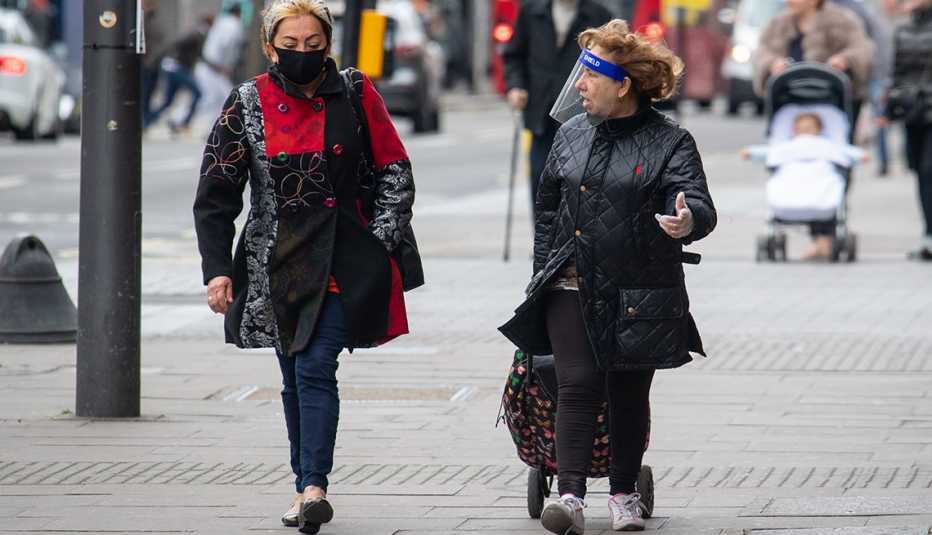AARP Hearing Center


By now we know we should be wearing face masks to protect others from potentially deadly infection when we leave the house. But face masks can be hot, and they can irritate the skin, fog glasses, make it difficult for some to breathe and create a world without smiles. It also can be difficult for people who have hearing loss to communicate when mouths are covered, muffling voices and hiding facial expressions.
Are clear plastic face shields, most frequently used in health care settings, a better option? Some say no: Health officials in Switzerland recently warned that shields alone may not offer as much protection as masks alone; in a recent outbreak at a hotel some employees and a guest who wore plastic visor-style shields tested positive for COVID-19, while those who wore masks did not.
The Centers for Disease Control and Prevention continues to recommend wearing “cloth face coverings in public settings where other social distancing measures are difficult to maintain.” But some health experts say shields appear to be very effective at preventing infection — maybe even more effective than masks — for someone going about regular daily activities and not in a high-risk health care setting.
Amesh Adalja, M.D., a pandemic preparedness expert at the Johns Hopkins Center for Health Security, says, “There's a lot of at least biological possibility to suspect that [shields] are definitely better than homemade face masks, and maybe even better than other types of masks as well, because they not only prevent you from spreading it … [and] because it also covers your eyes, it provides more protection to the mucus membranes of your face where you might be getting infected.”
James Cherry, M.D., a distinguished research professor and infectious disease expert at the David Geffen School of Medicine at UCLA, says that while experts aren't yet sure about how vulnerable our eyes are to infection from this coronavirus, “With many viruses, the eyes are important.” He points to measles and adenoviruses as examples of viruses that are known to infect people through their eyes.
DIY face shield tips
There are many online videos showing how to make your own shield in a few minutes, with different variations: a Canadian DIYer uses plastic binding covers you find at office supply stores; others use plastic bottles. (Note that these are not medical-grade or approved by any official health agency.)
This is one how to make a shield from an empty soda bottle.
You'll need:
- A 2-liter clear plastic bottle
- Cutting tool or scissors
- Small piece of weather stripping (others use packaging foam)
- Hole puncher
- String or ribbon
Directions:
- Cut off the end of the bottle a few inches from the bottom
- Cut off the top of the bottle, keeping a bit of the curvature, which will go under the chin
- Cut up the middle, so it becomes a somewhat flat piece of plastic
- Trim off sharp edges, and narrow a bit if necessary to fit the width of your face
- Peel off the backing of a piece of weather stripping and stick it to the top edge, which will go against your forehead
- Punch a hole at the top on either side, and thread a string or ribbon through
- Tie it around your head
Another benefit, says Adalja: With a mask, you may find yourself constantly adjusting it and therefore touching your face and possibly transferring the virus from your hands, but wearing a shield “doesn't really put you in a position where you're touching your face so much, because it's not as cumbersome to wear."
And finally, Adalja adds, “If you walk down the sidewalk, you can find lots of masks that are just discarded there, which are an infection control risk for other people. Whereas a face shield is something that people can just clean themselves and reuse."
A recent opinion piece in JAMA by Eli Perencevich, M.D., a professor of internal medicine and epidemiology at the University of Iowa Carver College of Medicine, and two of his colleagues pointed to such benefits of shields for infection prevention, and noted that “face shields appear to significantly reduce the amount of inhalation exposure to influenza virus, another droplet-spread respiratory virus. In a simulation study, face shields were shown to reduce immediate viral exposure by 96 percent when worn by a simulated health care worker within 18 inches of a cough.” In an April 19 tweet Perencevich wrote, “Biggest benefit of face shields would be inside crowded office situations where air exchanges aren't ideal."
Another benefit? With warmer weather, many may also find a face shield attached to a headband or cap cooler to wear than a cloth mask.


































































More on health
Surprising Places to Shop for Coronavirus Supplies Online
Amazon out of stock? Turn to these unexpected websites for masks, sanitizers, moreWhat You Need to Know About the Coronavirus
The latest news on COVID-19 and answers to frequently asked questions
How to Stay Safe as Things Open Up During the Pandemic
Experts weigh the risks of returning to restaurants, beaches, hair salons and more